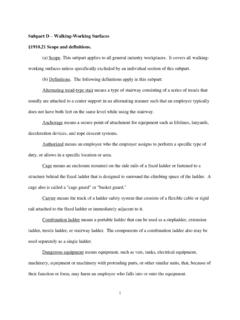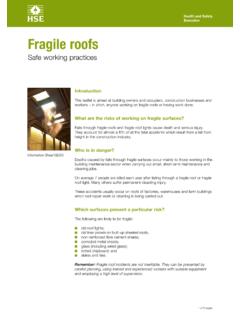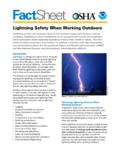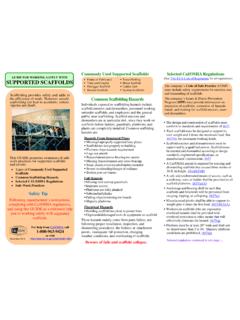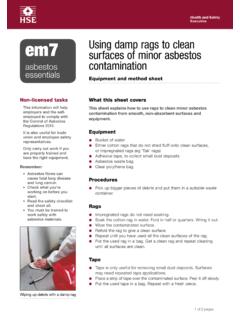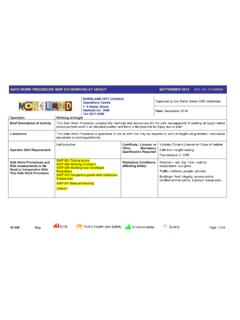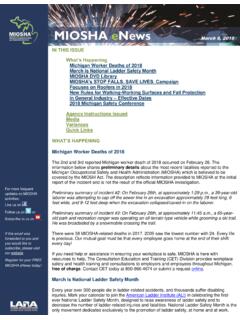Transcription of Histoplasmosis - Protecting Workers at Risk
1 Protecting Workers AT RISK Revised Edition DEPARTMENT OF HEALTH AND HUMAN SERVICES Centers for Disease Control and Prevention National Institute for Occupational Safety and Health NCID National Center for Infectious Diseases Histoplasmosis Protecting Workers at Risk Steven W. Lenhart, CIH Millie P. Schafer, PhD Mitchell Singal, MD, MPH Rana A. Hajjeh, MD DEPARTMENT OF HEALTH AND HUMAN SERVICES Centers for Disease Control and Prevention National Institute for Occupational Safety and Health National Center for Infectious Diseases December 2004 This document is in the public domain and may be freely copied or reprinted. Disclaimer: Mention of company names or products does not constitute endorsement by the National Institute for Occupational Safety and Health (NIOSH) or the National Center for Infectious Diseases (NCID), Centers for Disease Control and Prevention (CDC).
2 ORDERING INFORMATION To receive documents or more information about occupational safety and health topics, contact the National Institute for Occupational Safety and Health (NIOSH) at NIOSH Publications Dissemination 4676 Columbia Parkway Cincinnati, OH 45226 1998 Telephone: 1 800 35 NIOSH (1 800 356 4674) Fax: 1 513 533 8573 E-mail: or visit the NIOSH Web site at DHHS (NIOSH) Publication No. 2005 109 (supersedes 97 146) ii Foreword This booklet is a revised edition of the NIOSH document Histoplasmosis : Protecting Workers at Risk,which was originally published in September 1997. The updated information in this booklet will help readers under stand what Histoplasmosis is and recognize activities that may expose Workers to the disease-causing fungus Histoplasma capsulatum. The booklet also informs readers about methods they can use to protect themselves and others from exposure.
3 Outbreaks of Histoplasmosis have shared similar circumstances: People who did not know the health risks of breathing in the spores of H. capsulatum became ill and sometimes caused others nearby to become ill when they disturbed contaminated soil or accumulations of bird or bat manure. Because they were unaware of the hazard, they did not take protective measures that could have prevented illness. This booklet will help prevent such exposures by serving as a guide for safety and health professionals, environmental consultants, supervisors, and others responsible for the safety and health of those working near material contaminated with H. capsulatum. Activities that pose a health risk to Workers at these sites include disturbance of soil at an active or inactive bird roost or poultry house, excavation in regions where this fungus is endemic, and removal of bat or bird manure from buildings.
4 Local, State, and national public health professionals may also find this booklet useful for understanding the health risks of exposure to H. capsulatum so that they can provide guidance about work practices and personal protective equipment. The appendix consists of a fact sheet about Histoplasmosis printed in English and Spanish. This fact sheet is intended to help educate Workers and the general public about this disease. We urge employers, health agencies, unions, and cooperatives to distribute the fact sheet to all potentially exposed Workers . John Howard, Director, National Institute for Occupational Safety and Health Centers for Disease Control and Prevention iii Authors and Acknowledgments This booklet was written by Mr. Steven W. Lenhart, Dr. Millie P. Schafer, and Dr.
5 Mitchell Singal, National Institute for Occupational Safety and Health (NIOSH), Centers for Disease Control and Prevention (CDC), and Dr. Rana A. Hajjeh, National Center for Infectious Diseases (NCID), also of CDC. Secretarial support was provided by Ms. Ellen Blythe. Ms. Priscilla Wopat, Spokane Research Laboratory, NIOSH, was the document s editor. Ms. Pauline Elliott of NIOSH, format ted the document. The cover design and respirator drawings were created by Mr. Richard A. Carlson. The Histoplasmosis fact sheet was translated to Spanish by Dr. Veronica Herrera-Moreno and Dr. Tania Carreon-Valencia. The authors also extend gratitude to Dr. Donald L. Campbell, Ms. Teresa A. Seitz, Mr. Kenneth F. Martinez, and Ms. Dawn G. Tharr of NIOSH; Dr. Ted Pass II of Morehead State University; and Dr.
6 Myat Htoo Razak for their encouragement and invaluable con tributions to this work. iv CONTENTS Page Disclaimer .. ii Foreword .. iii Authors and Acknowledgments .. iv What is Histoplasmosis ? .. 1 How is Histoplasmosis diagnosed? .. 2 Culturing of H. capsulatum .. 2 Serologic tests .. 2 Detection of H. capsulatum antigen .. 3 Histoplasmin skin test .. 3 Where are H. capsulatum spores found? .. 3 Who can get Histoplasmosis and what jobs and activities put people at risk for exposure to H. capsulatum spores? .. 4 Should Workers who might be exposed to H. capsulatum have pre-exposure skin or blood tests? .. 5 What can be done to reduce exposures to H. capsulatum? .. 6 Excluding a colony of bats or a flock of birds from a building .. 6 Posting health risk warnings .. 7 Communicating health risks to Workers .
7 7 Controlling aerosolized dust when removing bat or bird manure from a building .. 7 Disinfecting contaminated material .. 8 Disposing of waste .. 8 Controlling aerosolized dust during construction, excavation, and demolition .. 9 Wearing personal protective equipment .. 9 v Contents (continued) What are the advantages and disadvantages of various kinds of respirators for Protecting Workers against exposure to H. capsulatum? .. 10 Assigned protection factors .. 10 Powered air-purifying respirators with hood, helmet, or loose-fitting Air-purifying, full-facepiece respirators; powered air-purifying respirators with half-facepiece or full facepiece; and continuous-flow, Pressure-demand, self-contained breathing apparatuses (SCBA) and combination pressure-demand, supplied-air respirators Respirator selection.
8 11 Disposable and elastomeric, half-facepiece, air-purifying respirators .. 11 facepiece and continuous-flow, supplied-air respirators with hood or helmet .. 13 supplied-air respirators with half-facepiece or full facepiece .. 14 Pressure-demand, supplied-air respirators with full facepiece .. 15 with auxiliary SCBA .. 15 Summary .. 16 What personal protective equipment other than respirators should Workers wear? .. 16 What other infectious agents are health risks for Workers who disturb accumulations of bat droppings or bird manure? .. 18 Cryptococcus neoformans .. 18 Chlamydia psittaci .. 18 Rabies .. 19 Where can I get more information about infectious diseases and answers to questions about worker health and safety? .. 20 References .. 21 Appendix .. 27 Histoplasmosis Fact Sheet (in English).
9 29 Histoplasmosis Fact Sheet (in Spanish) .. 31 vi Histoplasmosis Protecting Workers at Risk What is Histoplasmosis ? Histoplasmosis is an infectious disease caused by inhaling the spores of a fungus called Histoplasma capsulatum. Histoplasmosis is not contagious; it cannot be transmitted from an infected person or animal to someone else.(1) H. capsulatum is a dimorphic fungus, which means it has two forms.(2,3) It is a mold (mycelial phase) in soil at ambient temperatures, and after being inhaled by humans or animals, it produces a yeast phase when spores undergo genetic, biochemical, and physical alterations.(3) Spores of H. capsulatum are oval and have two sizes. Macroconidia (large spores) have diameters ranging from 8 to 15 micrometers ( m), and microconidia (small spores) range from 2 to 5 m in diameter.
10 (3) Yeast cells of H. capsulatum have oval to round shapes and diam eters ranging from 1 to 5 m.(3 5) Histoplasmosis primarily affects a person s lungs, and its symptoms vary greatly. The vast majority of infected people are asymptomatic (have no apparent ill effects), or they experience symptoms so mild they do not seek medical attention and may not even realize that their illness was Histoplasmosis .(6) If symptoms do occur, they will usually start within 3 to 17 days after exposure, with an average of 10 days.(1) Histoplasmosis can appear as a mild, flu-like respiratory illness and has a combination of symptoms, including malaise (a general ill feeling), fever, chest pain, dry or nonproductive cough, headache, loss of appetite, shortness of breath, joint and muscle pains, chills, and hoarseness.










